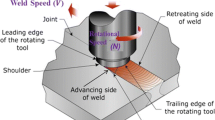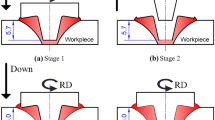Abstract
A new Eulerian model is established based on solid mechanics. With comparisons to the experimental data and the ALE model, the current model is validated. The power and the heat generations from pin side surface, pin tip surface, and shoulder contact surface in different rotating speeds are studied. Results indicate that the ratio of the heat input powers from the pin and the shoulder keeps constant in different rotating speeds. The velocity of the material flow around the welding tool and the slipping velocity are both increased with the increase of the rotating speed. The increase of the slipping velocity is the main reason for the increase of the heat input with the increase of the rotating speed. The torque from the shoulder contact surface is the major part of the total torque. The contribution to the total torque from the pin tip surface is the smallest.
Similar content being viewed by others
References
Mishra RS, Ma ZY (2005) Friction stir welding and processing. Mater Sci Eng R 50:1–78
Nandan R, Roy GG, Lienert TJ, Debroy T (2007) Three dimensional heat and material flow during friction stir welding of mild steel. Acta Mater 55:883–895
Yu ZZ, Zhang W, Choo H, Feng ZL (2012) Transient heat and material flow modeling of friction stir processing of magnesium alloy using threaded tool. Metall Mater Trans A 43:724–737
Albakri AN, Mansoor B, Nassar H, Khraisheh MK (2013) Thermo-mechanical and metallurgical aspects in friction stir processing of AZ31 Mg alloy—a numerical and experimental investigation. J Mater Process Technol 213:279–290
Bastier A, Maitournam MH, Van Dang K, Roger F (2006) Steady state thermomechanical modelling of friction stir welding. Sci Technol Weld Join 11:278–288
Arora A, Nandan R, Reynolds AP, Debroy T (2009) Torque, power requirement and stir zone geometry in friction stir welding through modeling and experiments. Scr Mater 60:13–16
Arora A, De A, Debroy T (2011) Toward optimum friction stir welding shoulder diameter. Scr Mater 64:9–12
Schmidt H, Hattel J (2005) A local model for the thermomechanical conditions in friction stir welding. Model Simul Mater Sci Eng 13:77–93
Zhang Z, Chen JT (2012) Computational investigations on reliable finite element-based thermomechanical-coupled simulations of friction stir welding. Int J Adv Manuf Technol 60:959–975
Aval HJ, Serajzadeh S, Kokabi AH (2011) Theoretical and experimental investigation into friction stir welding of AA 5086. Int J Adv Manuf Technol 52:531–544
Gök K, Aydin M (2013) Investigations of friction stir welding process using finite element method. Int J Adv Manuf Technol 68:775–780
Tutunchilar S, Haghpanahi M, Besharati Givi MK, Asadi P, Bahemmat P (2012) Simulation of material flow in friction stir processing of a cast Al-Si alloy. Mater Des 40:415–426
Buffa G, Hua J, Shivpuri R, Fratini L (2006) A continuum based model for friction stir welding—model development. Mater Sci Eng A 419:389–396
Zhang Z, Wan ZY (2012) Predictions of tool forces in friction stir welding of AZ91 magnesium alloy. Sci Technol Weld Join 17:495–500
Zhang Z, Zhang HW (2008) A fully coupled thermo-mechanical model of friction stir welding. Int J Adv Manuf Technol 37:279–293
Lorrain O, Favier V, Zahrouni H, Lawrjaniec D (2010) Understanding the material flow path of friction stir welding process using unthreaded tools. J Mater Process Technol 210:603–609
Zhang Z, Zhang HW (2009) Numerical studies on controlling of process parameters in friction stir welding. J Mater Process Technol 209:241–270
Zhang Z, Zhang HW (2007) Numerical studies on effect of axial pressure in friction stir welding. Sci Technol Weld Join 12:226–248
Zhang Z, Zhang HW (2009) Numerical studies on the effect of transverse speed in friction stir welding. Mater Des 30:900–907
Zhang Z, Liu YL, Zhang HW (2009) Effect of shoulder size on the temperature rise and the material deformation in friction stir welding. Int J Adv Manuf Technol 45:889–895
Zhang Z, Chen JT, Zhang ZW, Zhang HW (2011) Coupled thermo-mechanical model based comparison of friction stir welding processes of AA2024-T3 in different thicknesses. J Mater Sci 6:5815–5821
Zhang HW, Zhang Z, Chen JT (2005) The finite element simulation of the friction stir welding process. Mater Sci Eng A 403:340–348
Bedford A, Liechti KM (2004) Mechanics of materials. Pearson Education Asia Limited and Tsinghua University Press, Beijing
Belytschko T, Liu WK, Moran B (2000) Nonlinear finite elements for continua and structures. Tsinghua University Press, Beijing
Zhang Z, Zhang HW (2007) Numerical studies of preheating time effect on temperature and material behaviors in friction stir welding process. Sci Technol Weld Join 12:436–448
Tang W, Guo X, McClure JC, Murr LE, Nunes A (1998) Heat input and temperature distribution in friction stir welding. J Mater Process Manuf Sci 7:163–172
Lammlein DH, Delapp DR, Fleming PA, Strauss AM, Cook GE (2009) The application of shoulderless conical tools in friction stir welding: an experimental and theoretical study. Mater Des 30:4012–4022
Cui S, Chen ZW, Robson JD (2010) A model relating tool torque and its associated power and specific energy to rotation and forward speeds during friction stir welding processing. Int J Mach Tools Manuf 50:1023–1030
Leitão C, Louro R, Rodrigues DM (2012) Using torque sensitivity analysis in accessing friction stir welding-processing conditions. J Mater Process Technol 212:2051–2057
Author information
Authors and Affiliations
Corresponding author
Rights and permissions
About this article
Cite this article
Zhang, Z., Zhang, H.W. Solid mechanics-based Eulerian model of friction stir welding. Int J Adv Manuf Technol 72, 1647–1653 (2014). https://doi.org/10.1007/s00170-014-5789-4
Received:
Accepted:
Published:
Issue Date:
DOI: https://doi.org/10.1007/s00170-014-5789-4




